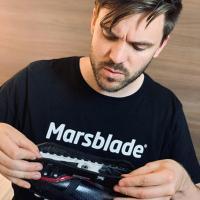* The main difference with the different rocker setting inserts is the size of the radius. Small radius means more movement, and bigger radius means less movement. During the development of R1 we tried a lot of different settings to find the best one for performance. What we discovered were that different players with different skating style prefer very different settings, so we decided to make the chassis customizable with changeable inserts. Other things we can adjust with different inserts is pitch/angle and balance point. O1 has a small, fixed, radius (= lot of movement in both directions). By adjusting the bushing on the O1 you can change how much you can rock, in other words how much you can push your centre of gravity forward or backward during skating.
* Lower part is an aluminium / magnesium alloy, and top part is glass fibre reinforced polyamid. What we have taken into consideration when choosing materials is mainly: strength (to withstand the forces of full match play over a long period of time), impact resistance (for puck hits), and manufacturability (to keep prices at a reasonable level and ensure stable production). Main pros for the polyamid is the freedom of shapes and geometries we can do, cons is that some players may reject the chassis if its made of any type of plastic (which does not really make sense to us, keep in mind that more or less every ice hockey chassis is made of plastic). Pros with the aluminium is strength in relation to weight, and that it is widely accepted by the players. Cons is that it makes the price of the product higher.
* You can absolutely use the R1 for training as well, its much more ice-like feel than a traditional, stiff, chassis. And putting a smaller wheel in the front on R1 is not a problem, but if you are looking for a chassis specifically for off-ice training then O1 is a the better choice, as it is optimized for training while R1 is optimized for maximum performance.




